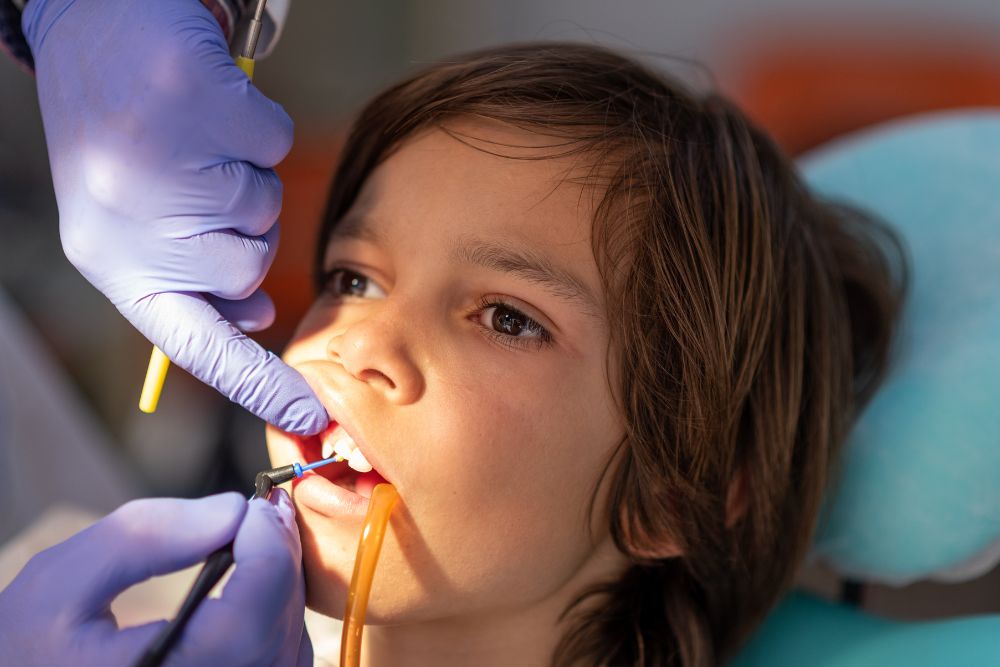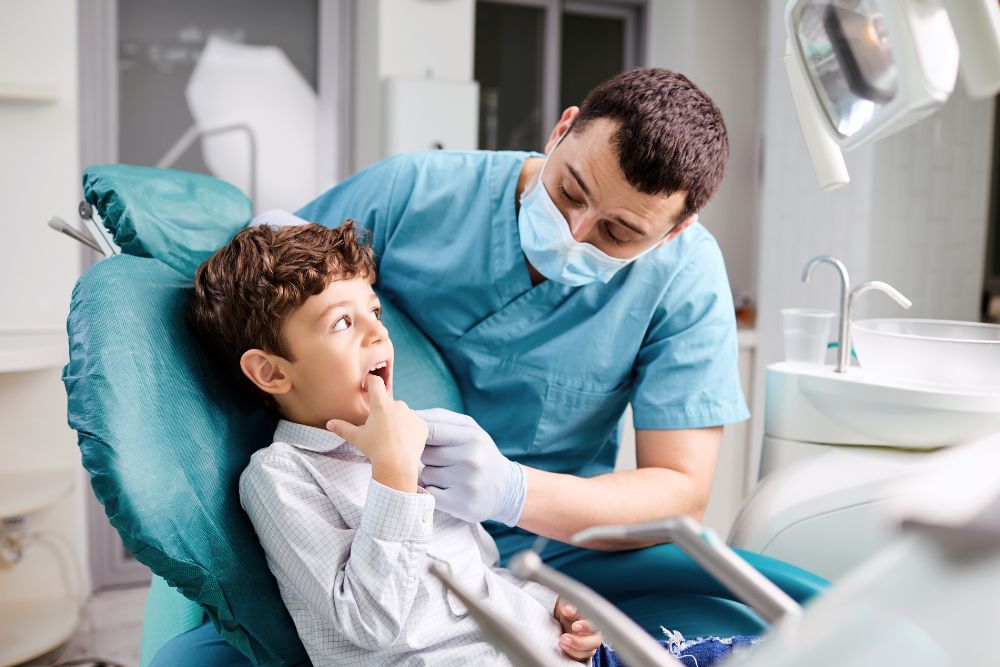When they do, quick action should be taken to ensure their continued dental health.
Let’s take a look a common kids’ dental emergencies and how to handle them effectively:
Toothaches
A toothache is a common dental emergency that causes persistent pain in or around the tooth. It can be caused by different things, like tooth decay, infection, or injury.
Toothaches can vary in intensity and can be triggered by hot or cold temperatures. This indicates that nerves may be involved.
If left unaddressed, a toothache can turn into a more severe issue. This is why it’s important to visit the dentist to identify the underlying cause.
At-Home Relief
If your child complains of tooth pain that won’t go away, rinse their mouth with warm water and gently floss to make sure there is no debris that is causing their discomfort.
Over-the-counter pain relievers for children can help with pain. Just make sure you follow the instructions and dosage guidelines.
Prevention
Encourage regular brushing and flossing to prevent toothaches. You should also take your child to a pediatric dentist for regular checkups and cleanings.
Professional Care
If the pain persists, take your child to a pediatric dentist for a thorough examination to find out what is causing the pain.
Knocked-Out Tooth
A knocked-out tooth happens when a tooth is completely displaced from its socket. This can happen because of accidents, falls, or sports injuries.
But just because a child’s tooth has been knocked out doesn’t mean it can’t be saved!
In these cases, time is of the essence. The longer the tooth has been outside of its socket, the lower the chances of successful re-implantation.
Proper first aid and prompt kids’ dental care can increase the chances of saving your child’s tooth.
IMPORTANT: If it’s your child’s baby tooth, don’t try to put it back in the gum! You also don’t have to worry about saving it. Have your child’s dentist check for any surrounding damage.
Immediate First-Aid
Hold the tooth by the crown, avoiding the roots, and gently rinse it with water. If you can’t place the tooth back into the gum, put it in a container of milk.
Prevention
If your child plays sports, have them wear a mouthguard. Also, educate your child about safety measures that will prevent accidents that lead to dental emergencies.
Professional Care
Quickly seek emergency dental care by contacting your kids’ dentist. The faster you can get them to a dentist, the better chance there is of saving the tooth.
Fractured or Chipped Tooth

kids dental emergency
A fractured or chipped tooth involves damage to the tooth structure. This can result from accidents, biting hard on objects, or dental trauma.
How severe the fracture is can vary, from minor cosmetic issues to more extensive damage that can affect the tooth.
Regardless of how bad the fracture or chip is, taking your child to a dentist is important so they can prevent further complications such as infections or tooth deterioration.
At-Home Relief
Gather any broken pieces and rinse your child’s mouth with warm water. Apply a cold compress to reduce swelling. Avoid using Aspirin or any numbing gel on the tooth (it can harm the surrounding tissue).
Prevention
Encourage a diet rich in calcium and other essential nutrients for strong teeth. You can also discourage habits like biting on hard objects.
Professional Care
Have a pediatric dentist examine the broken tooth to check for further damage or infection. They will also suggest the best course of action to fix the tooth.
Objects Caught Between Teeth
Having an object caught between your child’s teeth can cause them discomfort, pain, and potential damage to their gums and surrounding teeth. Common objects include food particles, floss, or small items.
Ignoring this issue can cause further irritation, gum inflammation, or even tooth misalignment.
Even if you successfully remove the object yourself, it’s recommended that you consult with a pediatric dentist in Edmonton to ensure there are no further complications.
Safe Removal
Try to gently remove the object between your child’s teeth with dental floss. Don’t use sharp or pointed objects.
Prevention
Teach your child proper oral hygiene practices, including regular flossing. Also, emphasize the importance of not chewing on non-food items.
Professional Care
If the object persists, contact a pediatric dentist for safe and professional removal. If the lodged object is removed but the area remains inflamed, your child should also see a dentist to rule out infection or damage.
Soft Tissue Injuries
Soft tissue injuries involve damage to the lips, cheeks, or tongue resulting from accidental bites, falls, or impacts.
These injuries can cause pain, swelling, and bleeding and require immediate attention.
While initial care includes cleaning the area and controlling bleeding, a professional evaluation is needed to assess how bad the injury is.
Immediate Care
Use a cold compress to help reduce swelling and control bleeding. See medical attention immediately if the bleeding is severe or won’t slow down or stop.
Prevention
Encourage your child to be careful during physical activities to prevent falls and injuries that can lead to soft tissue damage.
Teach your child to avoid chewing on hard objects, which can lead to accidental bites.
Professional Care
A pediatric dentist can take a look at the damage and provide guidance on how to encourage proper healing.
Orthodontic Emergencies
If your child has an orthodontic appliance, orthodontic emergencies can include things like broken wires or displaced brackets.
These situations can be uncomfortable for your child and may disrupt their orthodontic treatment plan.
It is not recommended that you try to fix these issues at home (unless it’s a temporary fix). Instead, seek professional orthodontic support to make sure the appliances are fixed and adjusted correctly.
Temporary Solutions
While you shouldn’t attempt to fix the appliance, you can try to gently reposition the wire or bracket using tweezers until you can get your child to a dentist or orthodontist.
Prevention
Make sure your child is following orthodontic care instructions provided by the dentist. Regular checkups can also help address potential issues before they become bigger problems.
Professional Care
Have your child seen by a professional as soon as possible. They can fix the issue so your child doesn’t continue to feel uncomfortable or in pain.
Kids Dental Emergencies in Edmonton
For reliable and expert care, reach out to our dedicated team at Oxford Dental, your trusted kids’ dentist in Edmonton.
We offer emergency services to ensure your child’s dental needs are addressed immediately.

